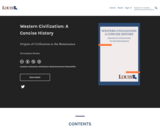Table of Contents:
I. Chapter 1 Understanding the Past
Chapter 1.1 Developing a Global Perspective
Chapter 1.2 Primary Sources
Chapter 1.3 Causation and Interpretation in History
Chapter 1 Section Summary
Chapter 1 Key Terms and Assessments
II. Chapter 2 Foundations of the Atlantic World
Chapter 2.1 The Protestant Reformation
Chapter 2.2 Crossing the Atlantic
Chapter 2.3 The Mercantilist Economy
Chapter 2.4 The Atlantic Slave Trade
Chapter 2 Section Summary
Chapter 2 Key Terms and Assessments
III. Chapter 3 Colonization and Economic Expansion
Chapter 3.1 European Colonization in the Americas
Chapter 3.2 The Rise of a Global Economy
Chapter 3.3 Capitalism and the First Industrial Revolution
Chapter 3 Section Summary
Chapter 3 Key Terms and Assessments
IV. Chapter 4 Revolutions in Europe and North America
Chapter 4.1 The Enlightenment
Chapter 4.2 The Exchange of Ideas in the Public Sphere
Chapter 4.3 Revolutions in Europe and North America
Chapter 4.4 Nationalism, Liberalism, Conservatism, and the Political Order
Chapter 4 Section Summary
Chapter 4 Key Terms and Assessments
V. Chapter 5 Expansion in the Industrial Age
Chapter 5.1 The Second Industrial Revolution
Chapter 5.2 Motives and Means of Imperialism
Chapter 5.3 Colonial Empires
Chapter 5.4 Exploitation and Resistance
Chapter 5 Section Summary
Chapter 5 Key Terms and Assessments
VI. Chapter 6 Life and Labor in the Industrial World
Chapter 6.1 Inventions, Innovations, and Mechanization
Chapter 6.2 Life in the Industrial City
Chapter 6.3 Coerced and Semicoerced Labor
Chapter 6.4 Communities in Diaspora
Chapter 6.5 Regulation, Reform, and Revolutionary Ideologies
Chapter 6 Section Summary
Chapter 6 Key Terms and Assessments
VII. Chapter 7 The War to End All Wars
Chapter 7.1 Alliances, Expansion, and Conflict
Chapter 7.2 The Collapse of the Ottomans and the Coming of War
Chapter 7.3 Total War
Chapter 7.4 War on the Homefront
Chapter 7.5 The War Ends
Chapter 7 Section Summary
Chapter 7 Key Terms and Assessments
VIII. Chapter 8 The Interwar Period
Chapter 8.1 Recovering from World War I
Chapter 8.2 The Formation of the Soviet Union
Chapter 8.3 The Great Depression
Chapter 8.4 Old Empires and New Colonies
Chapter 8.5 Resistance, Civil Rights, and Democracy
Chapter 8 Section Summary
Chapter 8 Key Terms and Assessments
IX. Chapter 9 The Causes and Consequences of World War II
Chapter 9.1 An Unstable Peace
Chapter 9.2 Theaters of War
Chapter 9.3 Keeping the Home Fires Burning
Chapter 9.4 Out of the Ashes
Chapter 9 Section Summary
Chapter 9 Key Terms and Assessments
X. Chapter 10 Cold War Tensions and Domestic Transformations
Chapter 10.1 The Cold War Begins
Chapter 10.2 The Spread of Communism
Chapter 10.3 The Non-Aligned Movement
Chapter 10.4 Europe amid Global Tensions and Decolonization
Chapter 10.5 Europe and the New World Order
Chapter 10 Section Summary
Chapter 10 Key Terms and Assessments
XI. Chapter 11 The Contemporary World and Ongoing Challenges
Chapter 11.1 A Global Economy
Chapter 11.2 Debates about the Environment
Chapter 11.3 Science and Technology for Today’s World
Chapter 11.4 Ongoing Problems and Solutions
Chapter 11 Key Terms and Assessments
Chapter 11 Section Summary
This textbook was created through Connecting the Pipeline: Libraries, OER, and Dual Enrollment from Secondary to Postsecondary, a $1.3 million project funded by LOUIS: The Louisiana Library Network and the Institute of Library and Museum Services. This project supports the extension of access to high-quality post-secondary opportunities to high school students across Louisiana and beyond by creating materials that can be adopted for dual enrollment environments. Dual enrollment is the opportunity for a student to be enrolled in high school and college at the same time.
The cohort-developed OER course materials are released under a license that permits their free use, reuse, modification and sharing with others. This includes a corresponding course available in Moodle and Canvas that can be imported to other platforms.



